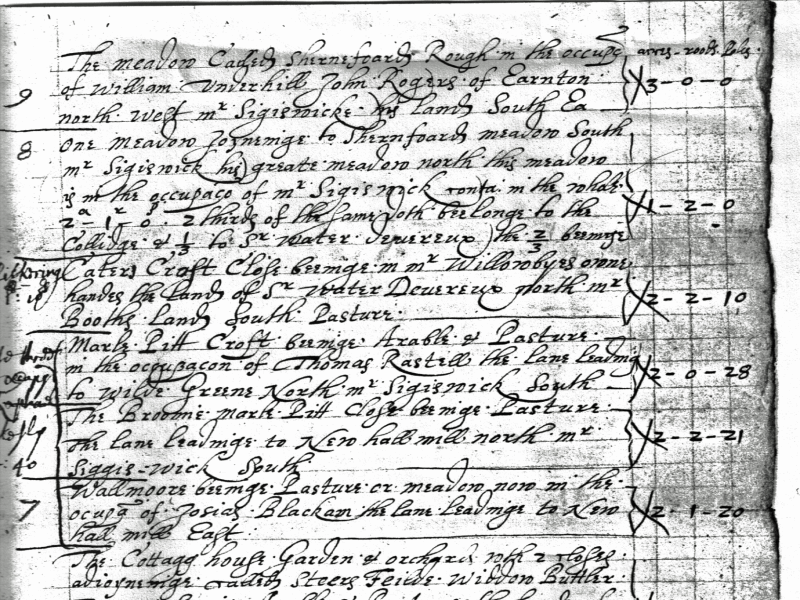In its pure form the feudal system allowed men to hold land from their feudal lord in return for services and other obligations, but from the beginning some of these services had been replaced by money rents. For example, in about 1200 Waleran Earl of Warwick, Lord of the Manor of Sutton Coldfield, confirmed an agreement whereby his tenant William Arden had agreed to sublet fourteen acres of land in Ashfurlong to William Thickbroom for two shillings a year free of all feudal services. Likewise in 1250 Walter de Bereford was allowed to pay a money rent in lieu of services by Thomas Earl of Warwick on two occasions, two shillings for twelve acres and eightpence for four acres. Thus in the thirteenth century land in Sutton was worth twopence an acre per year.
The rents due to the Earl of Warwick from all his Sutton tenants was reassessed in about 1400 by his Receiver General, John Bayesham, at £19. 6s. 10d, which approximates to 2,300 acres at twopence an acre (this may be an over-estimate of the acreage of the farmland, but if it was only 1,200 acres the rent would still be only 4d.). This appears in the Bailiff’s Account for 1433, which also includes items such as “3d increased rent from John Aleyn, cartwright, for 1 acre of arable land in Litill Sutton Field”, and “216 acres of land of various tenants at 18s. 10d. per annum”.
Sutton Coldfield’s Charter of Incorporation of 1528 includes a clause permitting the conversion of commons to privately-owned farmland on payment to the Corporation of twopence an acre per annum, the figure that seems to have remained constant for the previous three centuries. However, the feudal tenants of previous centuries still owed some services to their lord, and also had to pay an initial “Entry Fine”, duties which were worth at least another twopence per acre. Also, the cost of converting common land to farmland was high, probably the equivalent of another fourpence an acre.
The next evidence for land values in Sutton comes from a survey made in 1638 of the Sutton estate belonging to Emmanuel College Cambridge, part of which is reproduced here. Rents varied, for example the field called Cater’s Croft of 2½ acres, yielded £1/10/- annual rent, Sachmoores, nine acres, yielded £3/14/- and Foule Meadow, 5¼ acres, £4/10/-, the lowest being six shillings an acre, the highest eighteen shillings. This is a huge rise in the value of land since 1528 - nationally the price of land rose ninefold over the same period.
In Sutton wealthy men such as Thomas Gibbons took advantage of the clause in the Charter to take in hundreds of acres of common land at 2d an acre. By 1560 they found that they could sublet the land at its market value, probably four or five shillings per acre, and pocket the difference. Gibbons, like others who took advantage of the clause, was a member of the Warden and Society, and it seemed to other Suttonians that they were lining their pockets unfairly. In 1581 William Taylor and other inhabitants cited Thomas Gibbons and others before the Star Chamber Court alleging that they had appropriated to themselves seven hundred acres for their own use at a rent of only 2d an acre to the Corporation; as a result, the clause was rescinded, but land already taken in could be retained. At the time of the Charter, land values had been almost unchanged for hundreds of years, so there seemed no need to allow for inflation, and perhaps Thomas Gibbons and his friends could argue that they had taken in the land in good faith, and had been taken by surprise by the unprecedented rapid inflation.
Prices continued to rise, but never so fast as in the sixteenth century. A deed of 1747 records the lease of eight acres at £4 per annum, and a writer in 1762 stated “The rent of our best meadow land scarcely exceeds one guinea per acre, the arable land is let at14 or 15s.” A hundred years later, twenty-three acres in Maney were let at £42 per annum.
